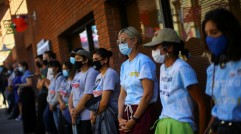US Uninsured Rate by Year: Many Latino Adults Still Uninsured As Overall Uninsured Rate Falls to New Lows in Gallup Data
The rate of uninsured U.S. adults continued to decline since the implementation of the Affordable Care Act (ACA), also referred to as Obamacare. However, according to the newest data, many Latinos in the U.S. continue to be uninsured.
Based on Gallup polling data, the fourth quarter of 2014 saw an average of 12.9 percent of American adults uninsured, which is a decline from 13.4 percent from the third quarter during the same year. Since the ACA went in effect in 2013, the uninsured rate fell by 4.2 percent, specifically from 17.1 percent during the fourth quarter of 2013.
According to Gallup's Jenna Levy, the latest 12.9 percent uninsured rate is the lowest percentage since Gallup and Healthways started recording the uninsured rate since 2008, which started at 14.6 percent.
"The uninsured rate declined sharply in the first and second quarters last year as more Americans signed up for health insurance through federal and state exchanges," wrote Levy. "After the open enrollment period closed in mid-April, the rate leveled off at around 13 [percent]."
Gallup noted the uninsured rate declined "across nearly all key demographics" since the implementation of the ACA. While the ACA's marketing efforts have largely focused the Latino community, which remains as the highest uninsured demographic with 32.4 percent, it is down 6.3 percentage points since the end of 2013's 38.7 percent.
The uninsured rate among the black community saw a large decrease by 7 percent compared to the fourth quarter of 2013. The uninsured rate among blacks remains in double-digit territory for the fourth quarter of 2014 with 13.9 percent.
In comparison to the fourth quarter of 2013, the rate of whites without health insurance finally hit single digits. For the fourth quarter of 2014, 8.5 percent of whites remained uninsured, which is down 3.4 percentage points from 11.9 percent one year ago.
Americans earning less than $36,000 in annual household income also saw steep declines as 23.8 percent remains uninsured, but it is down 6.9 percent from 30.7 percent one year ago. The uninsured rate among people earning more than $90,000 remains low at 3.4 percent, following a decline of 2.4 percent from 2013's fourth quarter.
"The percentage of 18- to 64-year-olds with Medicaid (8.6 percent) has also increased slightly over the past year, which is not surprising because many states expanded Medicaid eligibility so that more lower-income and lower-middle-income Americans could get affordable insurance. There was also a slight increase over the past year in the percentage of those under 65 with Medicare insurance."
Gallup's fourth quarter data was based on 43,000 interviews between Oct.1 and Dec. 30.
Gallup noted the uninsured rate could decline further as the second open enrollment period of obtain health insurance is underway until Feb. 15. As Latin Post reported, the U.S. Department of Health and Human Services (HHS) disclosed it received 6.6 million plan selections by consumers or automatic enrollments during the latest open enrollment period, which began on Nov. 15, 2014.
"Thanks to the Affordable Care Act, nearly 6.6 million Americans have access to quality, affordable health coverage for 2015 through the Federally Facilitated Health Insurance Marketplace," said HHS Secretary Sylvia Burwell said. "As we turn to the New Year, our focus is on helping every individual who is interested in quality, affordable health insurance to understand their options and to get covered."
The penalty fee for not having health insurance will vary on a person's income. For 2014, the IRS had announced the penalty is 1 percent of taxable income or $95 person, pending which cost is higher based on the 2014 federal tax return. According to HealthCare.gov, the penalty for individuals is only for those earning more than $10,000 for income. The maximum penalty is the national average premium for the bronze plan.
For the 2015 tax season, the penalty will increase to 2 percent of the yearly household income or $325 per person for the year. The IRS will expect the higher cost from the consumer. For families, the penalty is $325 per person, and $162.50 per child under 18 years old, although the maximum penalty per family will be $975.
__
For the latest updates, follow Latin Post's Michael Oleaga on Twitter: @EditorMikeO or contact via email: m.oleaga@latinpost.com.
Subscribe to Latin Post!
Sign up for our free newsletter for the Latest coverage!














